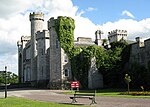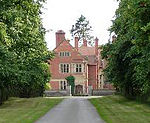Cefn Meiriadog

Cefn Meiriadog (sometimes Cefnmeriadog) is a rural community in Denbighshire, Wales, just south-west of the city of St Asaph. The boundary of the community on three sides is the river Elwy, which here forms the county boundary with Conwy County Borough. Arguably the largest settlement in the community is the hamlet of Bontnewydd. Also in the community are the hamlets of Groesffordd Marli where Ysgol Cefn Meiriadog is situated, and Cefn. The community is named for a small ridge of the same name (cefn in Welsh means "ridge"). It is said that the place was named for St Meiriadog, a 4th or 5th century Breton saint. Cefn Caves are nearby, where human and early Neanderthal remains dating back 250,000 years have been discovered. Visitors to the site have included Charles Darwin, in 1831. The site is known as Bontnewydd Palaeolithic site. There is a local spring, Ffynnon Fair ("St Mary's spring"), and it was once believed to have healing properties. The poet Siôn Tudur (1522 – 1602) lived at Plas Wigfair (GR028712) nearby.
Excerpt from the Wikipedia article Cefn Meiriadog (License: CC BY-SA 3.0, Authors, Images).Cefn Meiriadog
Geographical coordinates (GPS) Address Nearby Places Show on map
Geographical coordinates (GPS)
| Latitude | Longitude |
|---|---|
| N 53.24 ° | E -3.488 ° |
Address
LL17 0HE , Cefnmeiriadog
Wales, United Kingdom
Open on Google Maps










